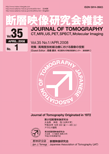高度進行肝細胞癌症例の予後因子に関する臨床的検討
萬 直哉 1)、成田 賢一 2)
1)富士市立中央病院 放射線科(現:東京都保健医療公社 荏原病院 放射線科)
2)東京慈恵会医科大学放射線医学講座
Clinical Analysis of Factors Influencing Transcatheter Therapy for Highly Advanced Unresectable Hepatocellular Carcinoma
Naoya Yorozu 1), Kenichi Narita 2)
1)Department of Radiology, Fuji-City General Hospital
(Department of Radiology, Tokyo Metropolitan Health and Medical Treatment Corporation Ebara Hospital)
2)Department of Radiology, The Jikei University School of Medicine
要旨
目的:高度進行肝細胞癌の経カテーテル治療に対する予後因子をretrospectiveに検討した。
対象と方法:1997年から2003年まで当院放射線科にて経カテーテル治療を行った高度進行肝細胞癌85例を対象とした。生存率は経カテーテル治療開始日を起点とし、Kaplan-Meier法を用いて算出した。生存率および治療後6ヶ月未満の早期死亡に影響を与える因子について単変量解析ならびに多変量解析を行った。
結果:全症例の1年、2年、3年生存率はそれぞれ52.1%、29.2%、18.1%であり、生存期間中央値は13ヶ月であった。生存期間に影響を与える因子は患者因子として年齢が、肝機能因子としてChild分類、血小板数が、腫瘍因子として腫瘍型、門脈浸潤、AFP値が、治療因子としてIVRが統計学的に有意であった。多変量解析では肝機能因子としてChild分類、血小板数が、腫瘍因子として門脈浸潤、AFP値が統計学的に有意であった。6ヶ月未満の早期死亡に影響を与える因子について単変量解析では肝機能因子として血小板数が、腫瘍因子として腫瘍型、門脈浸潤、AFP値が、治療因子としてIVRが統計学的に有意であった。
多変量解析では統計学的に有意な因子は認められなかったが、血小板数、腫瘍型、門脈浸潤が早期死亡に影響を与える可能性があった。
結論:1.門脈浸潤陽性、腫瘍塊状型、AFP値異常高値に該当する高度進行肝細胞癌に対するTAIの治療成績は不良であった。2.腫瘍破裂は必ずしも予後不良因子ではなかった。3.血小板数増多は高度進行肝細胞癌に対する治療において予後不良因子となる可能性がある。
Abstract
Purpose:To identify risk factors influencing transcatheter therapy in cases with highly advanced unresectable hepatocellular carcinoma in stage IV-A and stage IV-B and in cases with spontaneous rupture of hepatocellular carcinoma.
Materials and Methods:From April 1997 through September 2003, 85 patients with stage IV-A and stage IV-B hepatocellular carcinoma and with ruptured hepatocellular carcinoma were treated by transcatheter therapy. Subjects consisted of 63 patients with stage IV-A, 5 patients with stage IV-B, and 15 patients with ruptured hepatocellular carcinoma, in which emergency transcatheter therapy was performed. Transcatheter arterial embolization(TAE)was performed in 59 patients. Transcatheter arterial infusion(TAI: Chemolipiodolization/Reservoir therapy)was performed in 26 patients.
Results:The overall survival rates at 1, 2, and 3 years were 52.1%, 29.2%, and 18.1%, respectively. Univariate analysis revealed that patient's age, Child's classification, platelet count, serum α-fetoprotein(AFP)values, tumor types, portal vein invasion, and treatment methods were significant factors for the prediction of the prognosis after transcatheter therapy. Multivariate analysis revealed Child's classification, platelet count, portal vein invasion, and AFP values were significant prognostic factors. Between the patients who died in 6 months and the patients who survived over 6 months, univariate analysis showed that platelet count, tumor types, portal vein invasion, AFP values, and treatment methods were significant prognostic factors. In multivariate analysis, no prognostic factors were revealed significantly, however, platelet count, tumor types, and portal vein invasion were marginally significant prognostic factors.
Conclusion:Portal vein invasion, Child's classification B or C, massive type, high AFP values, and platelet count >15.0×104/mm3 were risk factors not anticipating improvement of prognosis after transcatheter therapy in patients with highly advanced unresectable hepatocellular carcinoma. Spontaneous rupture of hepatocellular carcinoma was not significant risk and prognostic factor compared with stage IV-A or stage IV-B hepatocellular carcinomas.
Key words
Hepatocellular Carcinoma, Portal Vein Invasion, Serum α-fetoprotein,Transcatheter Arterial Embolization
|

